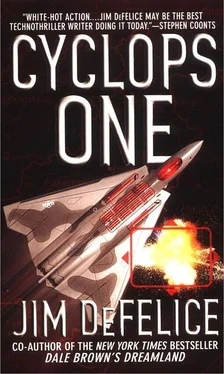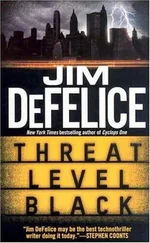By rights, Timmy should be the guy they were looking for. He was one of the F/A-22V pilots and ordinarily flew as Williams’s wingman; Colonel Howe had bumped him for the test, taking lead and slotting Williams behind him.
Timmy scanned his instruments, double-checking to make sure all systems were in the green. The F-16 had a smooth, easygoing personality, a can-do attitude that matched its versatility. She wasn’t particularly well suited to the SAR role, however; the propeller-driven and helicopter assets involved in the search could fly lower and slower much more comfortably, and had more eyes available for the search. That fact was reflected in Timmy’s assigned area, well out of the primary search grid. But neither the pilot nor the F-16 herself would have admitted this. Muscling her ailerons against the sharp wind vortices tossed off by the crags, the Falcon stiffened her tail and held off the breeze, sailing across the valley with the calm aplomb of a schooner on a glass lake.
The shared radio frequency being used to coordinate the search buzzed with voices. Grandpa — the J-STARS control that was coordinating the search — shifted assets around as the clouds slowly made their way off the mountains.
In a combat zone, a specific protocol governed when an airman would “come up” or broadcast on Guard frequency, the radio channel reserved for such emergencies and monitored by all of the searchers. These special instructions or spins conserved the limited battery power of the radios and made it more difficult for an enemy to detect or home in on the transmissions. But in this situation — and sometimes even in combat — a broadcast might be made at any time, especially if the downed airman heard a search plane overhead.
Timmy tried willing a broadcast into his ear; he heard only static, and even that was faint.
This long after a crash, what were the odds that someone had survived?
Not particularly good. Nor was it likely that one of the crew would be this far north. But it was possible. Moving at a couple of hundred miles an hour, you could travel relatively far in ten minutes, fifteen. There was no radar cover close to the mountains, and it was possible the planes had stayed in the air even longer. Punch out over the clouds, get pushed around a bit by the wind, hit your head somewhere — it was possible, if unlikely.
The searchers suddenly began chattering. They’d spotted something in a ravine. Metal.
Though the discovery was over a hundred miles to the west, Timmy felt his pulse jump. He slipped into another turn, dipping his wing and throttling back so he was just barely above stall speed, tiptoeing over the rough terrain. Something was there. He slipped around for another look.
The F-16’s General Electric F110-GE-129IPE power plant developed roughly 30,000 pounds of thrust and could move the Fighting Falcon out to Mach 2 in a heartbeat. The power plant had been engineered specifically to increase acceleration and performance at low altitude, allowing a pilot on a bombing run to accelerate quickly after his bombs were dropped. But here he wanted to do the opposite, and the engine grumbled slightly as the pilot dialed its thrust ever lower.
Timmy flew over the spot four times, making sure it was just a rock he’d seen, not a body. On his last pass he flew barely fifty feet from the ground, moving dangerously slow, just over 140 knots. Still, it was difficult to get a good glimpse of the ground, and the interplay of terrain and shadows played tricks on his eyes. Once more he broadcast his location on Guard, asking if Williams or anyone could hear him.
Going from the F/A-22V to the F-16 was a little like trading a BMW M5 for a Honda Civic. Both aircraft were well made, but the ideas behind their designs were very different. The base F/A-22 was a cutting-edge design aimed at creating the world’s best interceptor. All of the political wrangling and bureaucratic BS involved in its procurement — such as what Timmy viewed as the absurd designation change from F-22 to F/A-22—couldn’t gum up what was, at its core, a great fighting machine.
The F/A-22V took that design considerably further — without, he might have added, the political BS, since the work was all handled “off-line” by NADT. Specially designed to work with Cyclops as part of a new-era battle element, the aircraft was arguably the most versatile and capable ever constructed.
The F-16 was a lower-cost (though not cheap) jack-of-all-trades. Depending on its configuration, it could operate as an attack plane, a Wild Weasel or anti-SAM aircraft, a close-air-support mud fighter, or an interceptor. This Block 50/52 aircraft represented a substantial improvement over the original Block 15, the Air Force’s first production model, which nudged off the assembly line in the 1970’s. Even so, its base technology was older than Timmy and even Colonel Howe, and after flying the F/A-22V, the pilot would have felt severely handicapped in the F-16 in a combat situation.
Not overmatched, though. The F-16—which was known as the Viper as well as the Fighting Falcon, its more “official” nickname — had excellent maneuverability and acceleration at near-Mach and Mach-plus speeds, attributes that played well in a knife fight. The original lack of BVR or beyond-visible-range killing ability had been corrected with the fitting of AIM-120 AMRAAMs some years before, and the Block 50/52 aircraft’s APG-68 radar, with a range between thirty and forty-five miles and the ability to track up to ten targets simultaneously, was at least arguably as capable as anything the F-16 was likely to encounter.
Assuming, of course, that it didn’t encounter an American plane.
Timmy came to the end of the area he’d been assigned to patrol and began to track back south. As he did, the controller in the J-STARS coordinating the search effort hailed him.
“Florida Three,” he acknowledged.
“Florida, we have an area for you to check out, possible debris picked up by our Eyes asset.”
Eyes was a U-2 helping with the search.
“Florida Three acknowledges, Grandpa,” answered Timmy. “Feed me a vector.”
He selected military power, climbing quickly and tracking toward the area, which was so far north and east of the test area that he guessed it had to be a false lead. The mission specialist in the J-STARS gave him a detailed description of the terrain as he flew, saying there seemed to be a large piece of metal in or on a rockslide at the base of a sheer cliff in the foothills of the Canadian Rockies about two hundred miles due west of Edmonton. He described it as a broken silver pencil stuck in the side of a thousand-meter rockslide.
As Timmy neared the spot he took the plane down, asking the J-STARS specialist to describe the area again. J-STARS were E-8A or E-8C Boeing 707-type aircraft that had been developed as a joint project by the Air Force and Army. The aircraft had considerable surveillance equipment of their own, including a Norden AN/APY-3 multimode Side-Looking Airborne Radar. The complement of operators — there were a minimum of ten consoles, with room for up to seventeen, depending on the plane and mission — could process and coordinate information from a seemingly infinite variety of sources. They could direct and download targeting information to properly equipped Air Force attack planes as well as provide comprehensive battlefield intelligence to ground commanders. In this case, the operator was using a newly developed variant of the Joint Tactical Information Distribution System (or JTIDS) data link to pass an infrared feed directly from the U-2R to his console. Some F-16s were already equipped with gear that would have allowed the specialist to punch a few buttons and relay the image directly to Timmy’s cockpit. Had he been flying one of the F/A-22Vs, the data would have been added to the synthesized three-dimensional rendering of the area on the tactics screen. The plane’s computer would have calculated his best approach and likely time to target, along with a fuel matrix and a suggested wine.
Читать дальше












